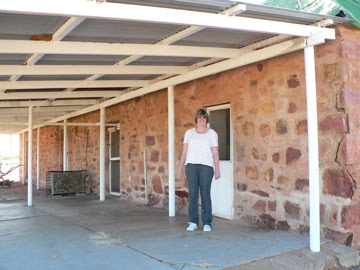At Barkly Homestead we received a timely reminder about the extra costs of living in the west: We were told they go through an extraordinary 500 litres of diesel a day just to keep their generators functioning for passers-by comfort. A sobering expense.
 |
| Barkley Homestead uses 500 litres of diesel each day |
The Barkley Highway took us across the Barkley Tableland towards Tennant Creek. These are map features from childhood school days. Tennant Creek was established quite late, in the 1930s, when a stockman’s horse kicked over a tracery of fine gold and started a small gold rush there. Tennant Creek gold was particularly tough and needed battering to extract which made it a noisy, hard job of work.
Before the gold, the Overland Telegraph Station, about 11 kms north of town, was the isolated attraction. It was one of about a dozen repeater stations along this route connecting communications from Port Augusta to Darwin in the 1870s. From Darwin, the communications went along undersea cable to Java from where they were transmitted to the rest of the world.
Parks and Wildlife Service of Northern Territory look after the Telegraph Station now and it is in much the same condition as when it was first built: the stone quarried from nearby has been injected, now, with silicon as a protective damp barrier. Everything is as it was: the root cellar to store locally grown vegetables and fruits; the smoke house, with hand-adzed Mulga supports and beaten kerosene tins decorating its front gable. An ant-bed oven, for cooking has been sited between the smoke house and the kitchen. The kitchen, telegraph office, battery room and bedroom for the station manager were beautifully built with keystone corners, compacted gravel floors, and ventilation holes that once may have been covered in wet hessian to enhance cooling. Outback were the huts for the linesmen, the blacksmith’s shop, and the butchery – still with its hanging racks and blockwood table.
 |
| Telegraph station - huge job of caring and sharing |
The station was the earliest building around, and you can just imagine the hoards of explorers, drovers, squatters and settlers who must have traipsed from south to north up this lonely isolated Telegraph track, and, inevitably, called in. Amazingly, a bicycle tourist rode past one day and called in for a bit of a blacksmith repair on his bike chassis. He was on an around Australia adventure trip, in 1897. He praised the care, comfort and skill offered to him in this isolated spot.
Supplies like flour, sugar and salt arrived every six months for such stations, but it is just as well there were gardens and stock yards, because, like remote lighthouse-keepers along the coast, these station keepers up the inland route would have been responsible for feeding and sheltering all who wandered in from the road: thirsty, hungry or just plain lonely and needing to talk.
What is interesting is how the personnel were entrusted by the southern authorities not only to find their way up north to locations like this, but once here to help build the station, manage and maintain it, and welcome the world outside through their doors. A huge job of pastoral care really. Even today, when it is just a quiet shell of what it once was, this station gives off a welcoming air of being a peaceful place.
You can just tell that folk were happy here.

No comments:
Post a Comment